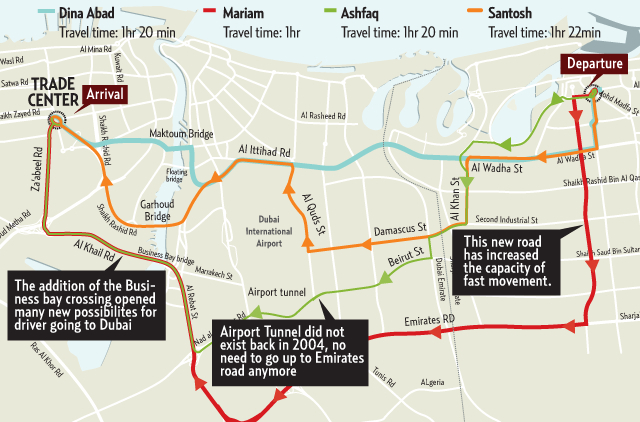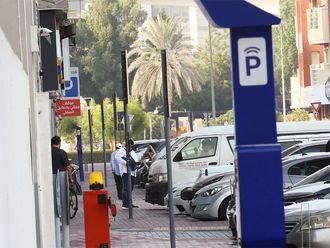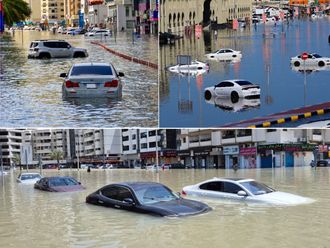
Dubai/Sharjah: While commuting between Sharjah and Dubai is no longer the nightmare it was a few years ago, the situation is still unsatisfactory for most motorists who face traffic jams during peak hours.
The driving time, however, has definitely fallen considerably during peak morning and evening hours, thanks to a number of road infrastructure projects completed in both emirates in the past few years.
Gulf News reporters conducted a field survey on Sunday, March 6, driving during peak hours on four famous routes connecting Sharjah with Dubai to find out whether the massive road development projects have made any difference in easing the woes of motorists.
Yes, they did is the answer because the average travel time has falalen by at least 40 per cent. The routes taken were Al Ittihad Road, Damascus Road, Beirut Road and Emirates Road.
We set off from the Sharjah Municipality office using different routes, with our final destination being the World Trade Centre.
The average travel time was a little more than 70 minutes whereas it was more than 120 minutes when Gulf News last conducted its survey using the same routes in October 2004.
Major projects
Though a huge number of people have moved from Sharjah to Dubai due to falling rents, the number of vehicles commuting between the emirates has in fact increased because of the population increase in both emirates. Many have also moved from Dubai to Sharjah to save money because rents in Sharjah have also gone down and accommodation is much cheaper than that in Dubai.
The traffic has eased because of some major infrastructure projects including the Al Ittihad Road improvement project which eased bottlenecks between Sharjah and Dubai.
The opening of the Business Bay Bridge provides a new road between Dubai and Sharjah, making it easier for motorists commuting between the two emirates. Construction of the Dubai Airport Tunnel is yet another project which has helped ease traffic.
Also, expansion of Emirates Road by the Dubai Roads and Transport Authority (RTA) from three to five lanes has also helped ease traffic issues with its increased capacity.
The Sharjah-Dubai Bypass road is yet another project which has taken up a huge chunk of traffic and has provided an alternate route for motorists, especially those travelling from the northern emirates to Abu Dhabi and Al Ain.
The increase in the number of public transport buses between Sharjah and Dubai has definitely encouraged more people to switch to public transport. Thousands of people use these buses every day to commute between the two emirates.
The traffic flow within Sharjah has also improved due to some major road projects being completed last year. One of them was Al Wahda Road improvement, which included a number of bridges and underpasses throughout the city.
The Al Wahda double-deck road which is 1.8 kilometres long has had a positive impact on traffic movement.
Another project that eased the traffic flow was on Maleha Road, which was launched in August 2010. Sharjah has also replaced most roundabouts with traffic light intersections to ease congestion.
Via Beirut Road
Noticeable change in travel time
I have been travelling between Sharjah and Dubai for the last 13 years and have seen the worst of traffic jams in all these years.
I was told to be part of a traffic field survey which we also did some six years ago. I dreaded the thought of doing it again as I drove for at least two hours and eight minutes when I did the survey last time. But the change was obvious as the travel time was only 80 minutes during peak hours in the morning from Sharjah Municipality office to Dubai World Trade Centre (31km) compared to 128 minutes six years ago, thanks to massive road infrastructure development.
I set off from Sharjah Municipality at around 7.40am accompanied by Gulf News videographer Rayeesa Absal, who was very excited to film traffic jams but was later a bit disappointed as we did not encounter real traffic congestion.
Traffic was just normal as I drove towards Al Buhaira Corniche and reached Al Khan Bridge on Al Wahda Street within 20 minutes at around 8am. It is where I faced the first traffic jam as traffic was crawling towards Dubai. It took me about 26 minutes to cover a distance of 2.5km from Al Khan Bridge to Caterpillar Intersection and then I turned right to enter Damascus Road and then onto the Beirut Road.
— Ashfaq Ahmed, Chief Reporter
Via Al Ittihad Road
There is still room for improvement
The morning drive from Sharjah to Dubai via Al Ittihad Road is by no means a smooth ride, but starting from Sharjah Municipality at 7.40am and considering that this trip took over two and a half hours a couple of years ago, I had every reason to fear the worst.
The drive to Al Wahda road was surprisingly not bad. I had to stop more than once at a few traffic lights, but traffic was moving considerably smoothly. I sailed through Al Wahda, and hit the first jam just after Al Khan Bridge. For about 40 minutes, traffic was moving at snail speed until I was well after Al Nahda Bridgea distance of about two kilometres. The rest of the drive to the World Trade Centre (WTC) was uneventful, and took only about 15 minutes from Al Mulla Plaza underpass to the WTC.
On the way to Dubai, the worst part of the trip usually ends when you exit Sharjah, but on the way back, trouble begins when you approach it, just before the Al Qiyada underpass. I started from WTC at 5pm, and if my destination was Al Nahda or Taawun areas, the ride would have taken 30 minutes, but having to drive back to the Sharjah Municipality roundabout, I arrived around 6.15pm, having spent most of that time between Al Mulla Plaza and Al Khan Bridge. I have to say that the situation has indeed improved, but covering the distance of 23 km in 1 hour and 20 minutes is not exactly a commuter’s dream come true.
—Dina Aboul Hosn, Staff Reporter
Via Emirates Road
Smooth sailing after crossing the border
As I left Sharjah Municipality at 7.40am on a Sunday morning, I was sceptical about how long it would take to reach the Trade Centre in Dubai since the start of the week is usually the most congested. As I headed towards Shaikh Khalifa Bin Zayed Road, which is a new underpass at Abu Shagara, I was caught up in some traffic but that was not out of the ordinary since traffic signals tend to stay red for a long time. But once I reached the road it was smooth sailing as my car whizzed along the bridge and within five minutes, I reached the service road that connects to Emirates Road.
Even though cars could be seen backed up all the way from Ajman, the drive was bearable as traffic was moving at a steady pace towards National Paints bridge. Most of the traffic congestion was in Sharjah but once I crossed the border it seemed that the roads had opened up. I then went on to Business Bay Bridge by taking the exit at Mirdif City Centre and within one hour I had reached the traffic junction behind the Trade Centre. I took the journey back home at 5pm and used the same route as in the morning, and was in for a pleasant surprise. The rush hour seems to have extended and no longer starts in the afternoon, but probably later in the evening. The afternoon commute was actually shorter and took me 40 minutes to reach Sharjah Municipality, as there was no traffic at National Paints bridge.
— Mariam M. Al Serkal, Staff Reporter
Via Damascus Road
Close encounters with 13 traffic signals
It was not exactly a cake walk. It took me an hour and 22 minutes on a cold and foggy morning to drive to Dubai World Trade Centre. That’s not a bad time at all if you know that I covered the 28.4km from the Sharjah Municipality roundabout on a Sunday morning when traffic is heavy. Anyone who commutes between Sharjah and Dubai would vouch for that.
Cut to a few years back, I distinctly remember the dreadful morning journeys I had made when my wife had overslept and missed her car lift to work. At the end of those trips more than two hours later I would be left nursing an aching leg (with all that gear shifts), and frayed nerves thanks to multiple incidents of road rage. We breezed through Al Wahda Street to Al Khan interchange. My first and the only bottleneck was in Sharjah Industrial Area 8 where I lost about 25 minutes getting past the traffic signal. On Damascus Road the traffic signals change fast— that too ate up precious time. My colleague Rabab Khan who was filming the trip just couldn’t believe that we made it in good time via Sharjah’s infamous industrial areas. Surprisingly the return trip took only 57 minutes. So what is the verdict? Would I take this route again if I have to in the morning? No, not at all, I know easier routes and fewer than the 13 traffic lights I encountered.
— Santhosh Kumar S., Deputy Editor, UAE
Have your say
How have you been affected by the decrease in property prices? Did you take advantage of the fall in rent prices? Is there a decrease in traffic on the routes you take? Let us know.













